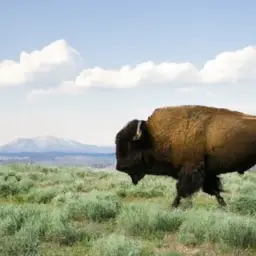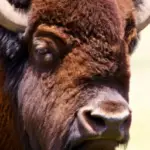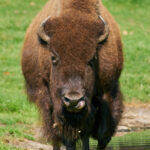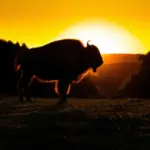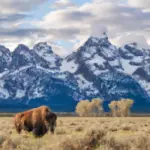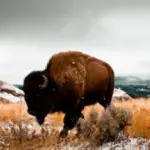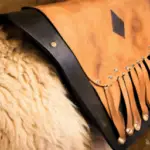If you’re a nature enthusiast looking to witness the majestic beauty of bison in Colorado, then look no further! “Where To See Bison In Colorado” is your ultimate guide to discovering the best locations across the state to observe these incredible creatures in their natural habitat. From vast grasslands to stunning national parks, this comprehensive resource will lead you to the most captivating bison sightings in Colorado. Embark on an unforgettable adventure and experience the wonder of these iconic animals.
Rocky Mountain Arsenal National Wildlife Refuge
Introduction to the Refuge
Rocky Mountain Arsenal National Wildlife Refuge is a fantastic destination in Colorado for bison sightings. Located just outside of Denver, this refuge offers visitors a unique opportunity to see bison up close in their natural habitat. With over 15,000 acres of prairie grasslands, wetlands, and woodlands, the refuge provides a perfect home for bison and other wildlife species.
Chance of Bison Sightings
When visiting Rocky Mountain Arsenal National Wildlife Refuge, you have a high chance of spotting bison. The refuge is home to a thriving herd of approximately 90 bison. These magnificent creatures can often be seen grazing in the open grasslands or resting in the shade of trees. Keep your eyes peeled and your camera ready for an unforgettable encounter with these majestic animals.
Best Viewing Tips
To maximize your chances of spotting bison, it is recommended to visit the refuge during the early morning or late afternoon when the animals are most active. Drive or walk along the designated wildlife viewing routes, such as the Wildlife Drive or the Lake Ladora Trail, to increase your chances of a close encounter. Remember to remain quiet and respectful, as sudden noises or movements might startle the bison.
Visitor Information
Rocky Mountain Arsenal National Wildlife Refuge is open from sunrise to sunset, seven days a week. There is no entrance fee, making it an affordable option for bison viewing. Visitors are encouraged to bring binoculars or a spotting scope for a closer look at the bison. Additionally, there are picnic areas and restroom facilities available for your convenience. Make sure to check the refuge’s website or contact their visitor center for the most up-to-date information before your visit.
Genesee Park
History of Bison in Genesee Park
Genesee Park has a rich history when it comes to bison conservation. It was here, back in 1914, that a small group of bison were brought from Yellowstone National Park to establish the first bison herd in Colorado. This historic event laid the foundation for the successful reintroduction of bison in the state.
Bison Herd and Viewing Spots
Today, Genesee Park is home to a thriving bison herd that numbers around 40 individuals. These magnificent animals can often be seen grazing in the park’s open meadows. Viewing spots, such as the Bison Overlook or the Genesee Mountain Trail, provide visitors with great vantage points to observe the bison in their natural habitat. Remember to keep a safe distance and observe the bison from a designated viewing area to ensure both your safety and the welfare of the animals.
Visitor Guidelines
When visiting Genesee Park, it is important to adhere to the park’s guidelines to protect the bison and their environment. Do not approach or feed the bison under any circumstances, as they are wild animals and can be unpredictable. Keep your pets on a leash and always stay on designated trails or viewing areas. Remember to pack out any trash and leave the park as you found it, respecting the wildlife and nature around you.
Hiking and Other Attractions
In addition to bison viewing, Genesee Park offers a variety of outdoor activities and attractions for visitors. Explore the park’s numerous hiking trails that wind through picturesque landscapes and offer stunning views of the surrounding mountains. If you’re interested in history, make sure to visit the Denver Mountain Parks Visitor Center, where you can learn more about the park’s bison conservation efforts and the area’s rich cultural heritage.
Daniel’s Park
Background of Daniel’s Park
Daniel’s Park is another wonderful destination in Colorado to see bison. This historic park, located in Douglas County, was once the summer hunting grounds for Native American tribes. Today, it has become a sanctuary for bison and other wildlife, providing visitors with a unique opportunity to witness these magnificent creatures in their natural habitat.
Bison Viewing Opportunities
Daniel’s Park is home to a small but thriving population of bison. These impressive animals can often be spotted grazing in the park’s grasslands or taking shelter under the shade of trees. While you can observe the bison from a distance, it is important to remember that these animals are wild and should not be approached. For a closer look, consider bringing binoculars or a camera with a zoom lens to capture their beauty.
Park Amenities
Daniel’s Park offers visitors a range of amenities to enhance their experience. Picnic areas are available, allowing you to enjoy a meal amidst the scenic surroundings. The park also features walking trails that allow you to explore the area further and potentially come across other wildlife species. Additionally, restroom facilities are provided for your convenience.
Travel and Safety Tips
When planning a visit to Daniel’s Park, it is advisable to check the park’s website or contact their visitor center for the most up-to-date information regarding operating hours and any restrictions or closures that may be in place. Remember to stay on designated trails and respect any signage or barriers in the park. Lastly, be prepared for changing weather conditions and bring essential items such as sunscreen, water, and appropriate footwear.
Ridge and Valley Wildlife Management Area
Location and Access
The Ridge and Valley Wildlife Management Area, located in northwestern Colorado, is a hidden gem for bison viewing. Situated in the scenic Yampa Valley, this expansive area encompasses approximately 24,000 acres of diverse habitats, including grasslands and forests. Access to the wildlife management area is permitted during daylight hours.
Bison Herd Details
Ridge and Valley Wildlife Management Area is home to a small but growing bison herd. This herd, consisting of around 20 individuals, roams freely across the grasslands and can often be seen grazing in the open spaces. Spotting the bison may require some patience and luck, as they can move throughout the area. Remember to observe the bison from a safe distance and avoid any sudden or threatening behavior that may disturb them.
Ideal Times for Bison Viewing
To increase your chances of spotting bison at the Ridge and Valley Wildlife Management Area, it is recommended to visit during early morning or late afternoon. During these times, the bison are typically more active and visible. Keep in mind that wildlife sightings are never guaranteed, but the beautiful landscapes and diverse flora and fauna of the area make every visit a worthwhile experience.
Staying Safe in the Area
When exploring the Ridge and Valley Wildlife Management Area, it is important to prioritize safety. Weather conditions in the area can change rapidly, so be prepared for varying temperatures and bring appropriate clothing layers. Carry a map and compass, as GPS signal can be unreliable in remote areas. Additionally, inform someone of your plans and expected return time before venturing into the wildlife management area.
Custer State Park
Park Highlights
Custer State Park, located in South Dakota, is a must-visit destination for bison enthusiasts. With over 71,000 acres of breathtaking landscapes, including rolling prairies and towering granite peaks, this park offers visitors a chance to witness the beauty of bison in an awe-inspiring setting. In addition to bison, the park is home to other wildlife such as pronghorn, elk, and coyotes.
Bison Spots and Tour Offerings
Custer State Park boasts a robust bison population, with over 1,300 individuals. The best place to view bison in the park is the Wildlife Loop Road, a scenic route that winds through prime bison habitat. Bison can often be seen grazing alongside the road or crossing it, creating a truly immersive wildlife experience. For those seeking a guided tour, the park offers a Buffalo Safari Jeep Tour, where knowledgeable guides will take you on a journey to see the bison up close.
Visitor Services
Custer State Park provides a range of visitor services to make your experience enjoyable and convenient. The park offers camping facilities, allowing you to spend more time immersed in nature. Picnic areas are available for those who wish to enjoy a meal amidst the park’s stunning landscapes. If you’re looking for a unique souvenir, visit the park’s visitor center, where you can find a variety of bison-themed merchandise.
Best Time to Visit
Custer State Park is a year-round destination, each season bringing its own unique charm. The best time to view bison in the park is during late spring and early summer when the animals are often calving. Fall is also a great time to visit, as the park’s landscapes transform into a kaleidoscope of vibrant colors. Remember to check the park’s website or contact their visitor center for any seasonal closures or restrictions.
Buffalo Herd Nature Preserve
Preserve Overview
The Buffalo Herd Nature Preserve, located near Denver, is a wonderful place to observe bison in their natural habitat. As one of the largest publicly accessible bison preserves in Colorado, it offers visitors a unique opportunity to witness these majestic creatures up close. The 1,200-acre preserve aims to protect the bison herd and educate the public about their importance to the region’s history and ecology.
Guidelines for Bison Sightings
When visiting the Buffalo Herd Nature Preserve, it is important to follow the guidelines to ensure a safe and enjoyable experience. Stay on designated trails and viewing areas to avoid disturbing the bison and their habitat. Do not approach, touch, or feed the bison, as these are wild animals and can be unpredictable. Be respectful of other visitors and wildlife by keeping noise to a minimum and packing out any trash.
Visitor Facilities
The Buffalo Herd Nature Preserve provides a range of facilities to accommodate visitors. There is a visitor center where you can learn more about bison conservation efforts and the history of the preserve. Picnic areas are available, allowing you to enjoy a meal surrounded by beautiful landscapes. Additionally, restroom facilities are provided for your convenience.
Other Wildlife
While the main attraction at the Buffalo Herd Nature Preserve is the bison, the preserve is home to a variety of other wildlife species. Keep an eye out for prairie dogs, deer, and a multitude of bird species as you explore the area. The preserve’s diverse flora and fauna offer plenty of opportunities for nature enthusiasts and wildlife photographers.
Denver’s City Park
Features of Denver’s City Park
Denver’s City Park is not only a hub for recreational activities but also a great location to catch a glimpse of bison. Spanning over 330 acres, this urban park offers visitors a tranquil retreat amidst the bustling city. Besides bison sightings, the park features lakes, gardens, picnic areas, playgrounds, and even a golf course, providing something for everyone to enjoy.
Bison in the Park
You might be surprised to learn that Denver’s City Park is home to a small herd of bison. These iconic animals can often be seen grazing in their dedicated enclosure, providing a unique opportunity to observe them in an urban setting. While you may not have the chance to see them roam freely, the bison at Denver’s City Park serve as a reminder of Colorado’s rich history and connection to the land.
Viewing Recommendations
To get the best view of the bison at Denver’s City Park, head to the designated bison viewing area located near the intersection of 23rd Avenue and Colorado Boulevard. From there, you can observe the animals as they go about their daily activities, including grazing and interacting with each other. Remember to maintain a safe distance and refrain from feeding or approaching the bison to ensure both your safety and the welfare of the animals.
Park Activities
Denver’s City Park offers a wide range of recreational activities for visitors of all ages. Take a leisurely stroll around the park’s picturesque lakes or enjoy a picnic on the grassy lawns. Engage in outdoor sports such as volleyball, tennis, or soccer, or challenge yourself to a round of golf at the City Park Golf Course. With the Rocky Mountains as a backdrop, Denver’s City Park provides a perfect blend of urban convenience and natural beauty.
Colorado Bison Adventure Tours
Tour Options
For those seeking an immersive and educational experience with bison, Colorado Bison Adventure Tours offers a variety of guided tours. These tours take you deep into Colorado’s iconic landscapes, providing you with an up-close and personal encounter with bison. From private photography tours to multi-day expeditions, there is a tour option that suits every adventurer’s preferences.
What to Expect on a Bison Tour
On a bison tour with Colorado Bison Adventure Tours, you can expect to learn about the history, behavior, and conservation efforts of these magnificent creatures. Knowledgeable guides will share fascinating insights into the bison’s role in shaping Colorado’s ecosystems and the challenges they face today. With expert guidance, you will have the opportunity to observe bison in their natural habitat and capture breathtaking photographs.
Booking and Pricing Information
To book a bison tour with Colorado Bison Adventure Tours, visit their website or contact their customer service. Tour prices vary depending on the duration and type of tour selected. Private photography tours typically offer a more personalized experience but may have higher pricing options. Be sure to check the tour details and any additional requirements, such as equipment or physical fitness, before making a reservation.
Customer Reviews
Previous customers of Colorado Bison Adventure Tours have praised the company for its knowledgeable guides, incredible wildlife encounters, and memorable experiences. Many have highlighted the exceptional service and professionalism of the staff, as well as the educational aspect of the tours. Reading customer reviews can provide valuable insights into the quality of the tours and help you make an informed decision when planning your bison adventure.
Safety Tips when Viewing Bison
Maintaining Safe Distances
When viewing bison, it is crucial to maintain a safe distance to ensure both your safety and the well-being of the animals. A general rule of thumb is to stay at least 25 yards away from bison, but a greater distance may be necessary depending on the animal’s behavior. Remember that bison are wild animals and can charge if they feel threatened or stressed. Always observe them from designated viewing areas and never approach them.
Understanding Bison Behavior
Educating yourself about bison behavior is essential when viewing them in the wild. Be aware that bison can be unpredictable and may exhibit warning signs such as pawing the ground, shaking their heads, or lowering their tails. If you observe any of these behaviors, it may indicate that the bison is agitated and you should take immediate steps to increase your distance. Respect the bison’s space and allow them to behave naturally without interference.
Emergency Procedures
In the unlikely event that you find yourself in a potentially dangerous situation with a bison, it is important to know how to react. If a bison charges, seek shelter behind a large object, such as a tree or rock, if available. If no shelter is nearby, run away from the bison while maintaining a straight line and avoiding any obstacles. Never attempt to outrun a bison, as they can reach speeds of up to 35 miles per hour.
Respecting Wildlife
When viewing bison or any other wildlife, it is crucial to treat them with respect and consideration. Do not attempt to feed or approach the animals, as this can disrupt their natural behavior and potentially harm them. Avoid making loud noises or sudden movements that may startle the animals. Remember that you are a guest in their habitat and should do your part to minimize your impact and preserve the pristine wilderness that they call home.
Are the Locations to See Bison in Wyoming Similar to Those in Colorado?
When it comes to where to see bison in Wyoming, the locations differ from Colorado. Wyoming is known for its vast natural landscapes and national parks like Yellowstone and Grand Teton, which offer excellent opportunities to spot bison in their natural habitat. In Colorado, you can find bison herds in places like Rocky Mountain Arsenal National Wildlife Refuge and Genesee Park.
Conservation Efforts for the Bison in Colorado
History of Bison Conservation
The bison, also known as the American buffalo, once roamed the plains of North America in vast numbers. However, due to overhunting and habitat loss, their population plummeted dramatically. Efforts to conserve the bison began in the early 20th century, and today, Colorado plays a vital role in the conservation of these iconic animals. Through reintroduction programs, protected areas, and cooperation between public and private entities, the state has made significant strides in preserving bison populations.
Current Bison Restoration Projects
Colorado is actively involved in ongoing bison restoration projects to increase the population and genetic diversity of these majestic creatures. Numerous organizations, such as the National Park Service, state wildlife agencies, Native American tribes, and private landowners, work together to reintroduce bison to their historic habitats. These projects aim to create self-sustaining herds that contribute to the overall health of the ecosystems they inhabit.
How to Support Bison Conservation
If you are passionate about bison conservation, there are several ways you can contribute to these efforts. Consider visiting and supporting bison sanctuaries, national parks, or wildlife management areas, as your entrance fees and donations help fund conservation initiatives. Educate yourself and others about the importance of bison to the ecosystem and the cultural heritage of the United States. Get involved with local conservation organizations or volunteer opportunities that focus on bison conservation and habitat restoration.
Education and Awareness Programs
Education and awareness play a vital role in the conservation of bison. Many organizations and parks offer educational programs, workshops, and guided tours that provide valuable insights into the biology, history, and conservation efforts surrounding bison. By participating in these programs, you can deepen your understanding of these magnificent animals and inspire others to appreciate and safeguard their future. Spread awareness through sharing your experiences and knowledge, and encourage others to join in the preservation of this iconic species.
In conclusion, Colorado offers a variety of opportunities to view bison in their natural habitats. From national wildlife refuges to historic parks and organized adventure tours, there is something for every bison enthusiast. Remember to always prioritize safety, respect wildlife and their environments, and support the conservation efforts that ensure the continued existence of these magnificent animals in Colorado and beyond.

